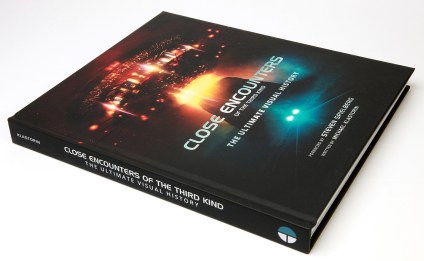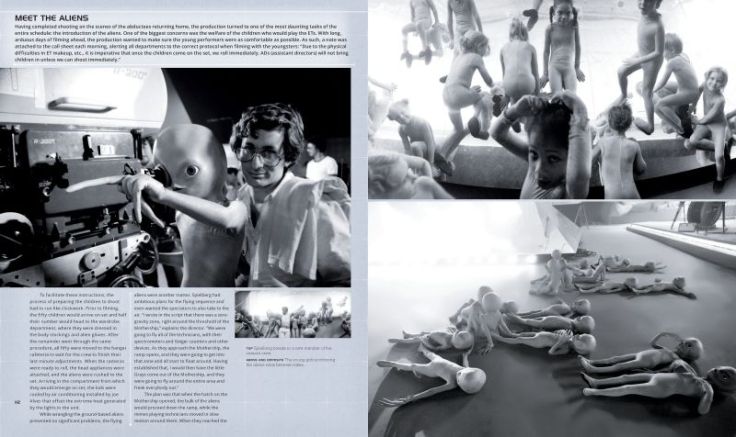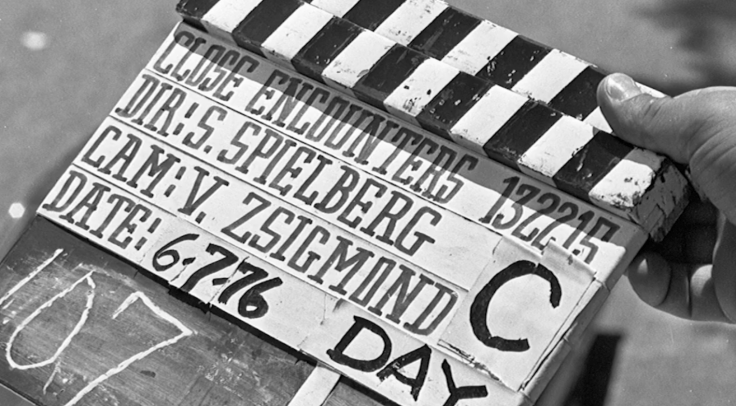CLOSE ENCOUNTERS OF THE THIRD KIND made a huge impact on me when I saw it as an impressionable nine-year-old way back in November of 1977. More than four decades later, I can’t stop thinking about it. The film touched a nerve deep inside of me, not unlike that of Roy Neary after his personal encounter with mysterious extraterrestrials. I became obsessed. I saw it multiple times in the theater. I talked with my friends about it daily. I drew pictures and storyboards of aliens, spaceships, and flying saucers. I carved lines in my mashed potatoes at dinner. I wanted to see a U.F.O. for real. I wanted to know for a fact that We Are Not Alone.
The film touched a nerve deep inside of me, not unlike that of Roy Neary after his personal encounter with mysterious extraterrestrials. I became obsessed. I saw it multiple times in the theater. I talked with my friends about it daily. I drew pictures and storyboards of aliens, spaceships, and flying saucers. I carved lines in my mashed potatoes at dinner. I wanted to see a U.F.O. for real. I wanted to know for a fact that We Are Not Alone. 
But since friendly invaders weren’t going out of their way to tap on my bedroom window and whisk me away to another world in 1977, I had to be satisfied with whatever merchandise I could get my hands on: The Marvel comic-book adaptation; the film’s Fotonovel; Bob Balaban’s CLOSE ENCOUNTERS OF THE THIRD KIND DIARY, repeated listens to John Williams’ brilliant soundtrack and Meco’s disco version on 45.
I soaked up all the details I could get my hands on and became somewhat of a know-it-all expert at 10 years old. Now, a lifetime later, I get to supplement all those studied factoids with Close Encounters of the Third Kind: The Ultimate Visual History (written by Michael Klastorin for HarperCollins), the new behind-the-scenes companion book was timed for the film’s 40th anniversary.
It’s full of material I’ve never seen before, including compelling concept art, amazing set photos, storyboards, script notes, trade paper clippings, memos, and correspondence. It also collects a number of narratives that paint a much broader context of what it was like to make the film compared to Bob Balaban’s singular CLOSE ENCOUNTERS OF THE THIRD KIND DIARY recollections published in 1978. 
In the new book’s foreword by Steven Spielberg, the writer/director says that the seeds of the film were planted when his father took him as a boy to watch the Perseid meteor shower. He also explains that the project remains one of his most personal: “The idea that we are not alone — the hope that we are not alone — is a theme I’ve returned to in several films since [the release of CLOSE ENCOUNTERS], some frightening, some gentle. But the optimism of CLOSE ENCOUNTERS will always remain close to my heart.”  Some interesting nuggets of information about the making of CLOSE ENCOUNTERS and what could have been, taken from THE ULTIMATE VISUAL HISTORY:
Some interesting nuggets of information about the making of CLOSE ENCOUNTERS and what could have been, taken from THE ULTIMATE VISUAL HISTORY:
- The character of Roy Neary, played by Richard Dreyfuss, was originally named Norman Greenhouse.
- Spielberg hoped to have Steve McQueen play the part of Greenhouse, but the star turned it down because he candidly declared that he would be unable to cry on camera. The director also pursued Dustin Hoffman, Al Pacino, and Jack Nicholson. As the character evolved into an “everyman” type of character, Dreyfuss became the logical choice.
- In the second draft of the screenplay, there is an active UFO-watcher group known as SPIWGOAH: The Society for the People Interested in What’s Going On Around Here.
- In a deleted scene, Roy Neary tries to make sense of the shape of a Jell-O mold at a neighborhood block party (between fascination with the looming mountain shape of mashed potatoes, shaving cream, and a pillow).
- The iconic Devil’s Tower location in Wyoming was originally a fictional location scripted as “Wamsutter Mountain” and Spielberg briefly considered using Monument Valley, but passed on it since he knew that cinematic landscape belonged to legendary director John Ford.
- Also before the Devil’s Tower location was chosen, Spielberg initially envisioned having the Mothership land in a small town between two fast-food restaurants, but dismissed the idea after production designer Joe Alves mocked up the shot.
- An Air Force character in an early draft of the script was named Major Benchley after JAWS author Peter Benchley.
- In order to elicit natural, organic responses of concern and curiosity from little Cary Guffey who played Barry, Spielberg dressed two crew members as a clown and a gorilla.
- To create the memorable “Five Notes” motif used throughout the film, John Williams wrote several hundred combinations. He found it difficult because, “Seven notes is a melody, and three notes is just for the doorbell ring … five notes is somewhere in between.”
Many people don’t take the time to consider how many ideas are first set on paper before being totally revised, eliminated, morphed, added later, or expanded in the filmmaking process. Where CLOSE ENCOUNTERS is concerned, there are some incredible, alternate possibilities to say the least.

- Spielberg and his alien friends: An interior spread from CLOSE ENCOUNTERS OF THE THIRD KIND: THE ULTIMATE VISUAL HISTORY
You can read more of my CLOSE ENCOUNTERS musings HERE along with a collection of original, vintage Lobby Cards from the film.
You can also purchase Close Encounters of the Third Kind: The Ultimate Visual History and then shop to your heart’s content for other things on Amazon (like Collectible Toys
) while contributing a few shekels towards the upkeep of IT CAME FROM…
###
Please take a moment to “like” IT CAME FROM…on Facebook and “follow” on Instagram and on Twitter for more great retro content.
Then read more Steven Spielberg-related articles, see more of my ENTERTAINMENT TONIGHT-related tales and interviews, reviews, STAR WARS musings, Famous Monsters fun, and more cool vintage movie lobby cards.


